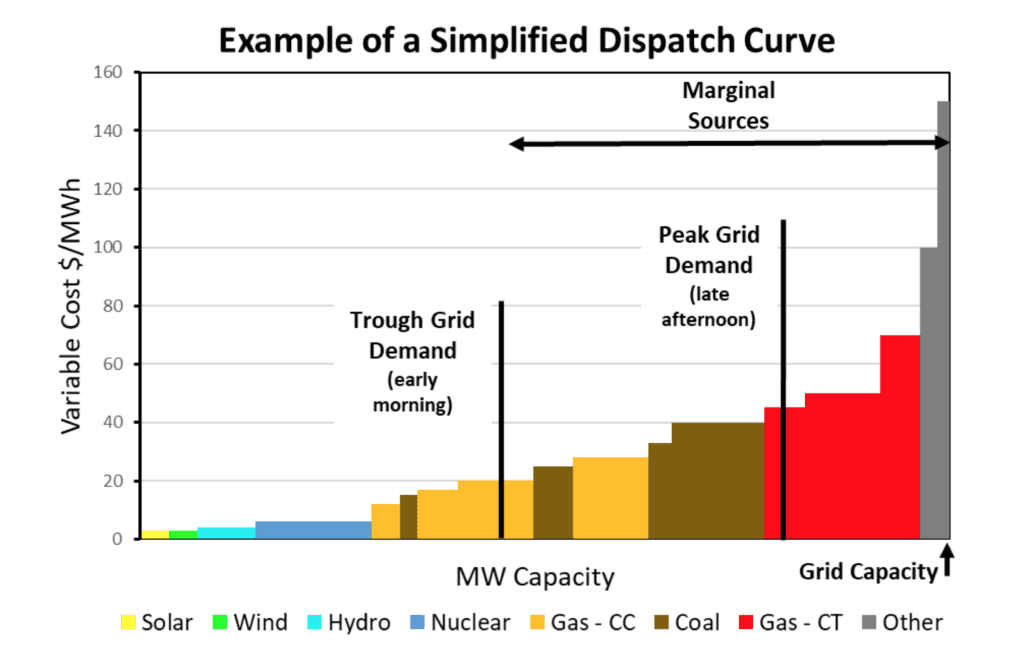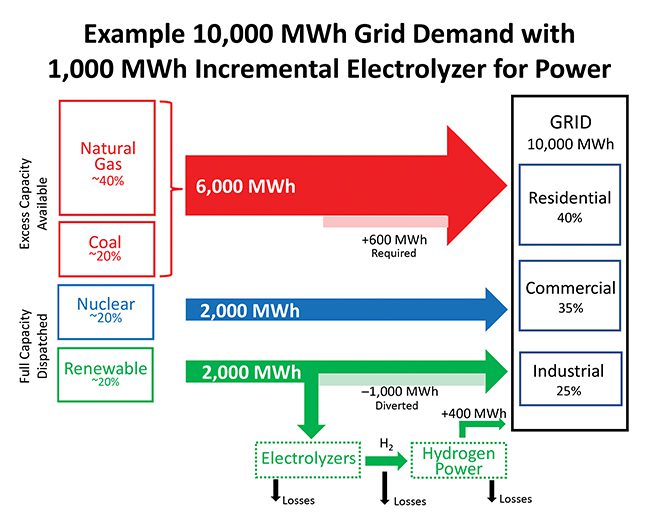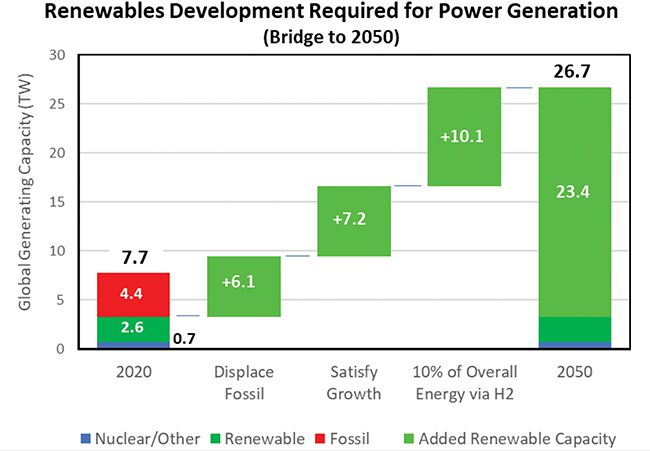Should We Really Use Renewable Electricity to Make Green Hydrogen? Not Always
There’s a growing belief that hydrogen will play a key role in lowering CO2 emissions. However, there are several caveats in realizing that vision, and in some cases, hydrogen may not be the right choice.
To many, hydrogen’s CO2-free combustion characteristics make it an attractive replacement for the portion of fossil fuels that are currently burned to release energy, including applications in power generation, transportation fuels, industrial processes, and central heating. However, there are some problems with using hydrogen on a large scale to replace fossil fuels—the biggest among these is how to make enough of it without actually increasing CO2 emissions, even if it is so-called “green” hydrogen.
The amount of hydrogen needed to supply even a fraction of our future energy requirements is massive. Just 10% of global primary energy consumption in 2050 would theoretically require more than 670 million metric tons per year of hydrogen, which is nearly 10 times the amount made today. And the methods commonly used today to generate hydrogen emit large amounts of CO2 as a byproduct, making them unacceptable without further mitigation measures.
The primary way envisioned to make much of this hydrogen is by electrolysis. In this process, electricity is supplied to an electrolyzer, which splits water molecules into hydrogen and oxygen with no direct CO2 emissions. But to meet the definition of renewable or green hydrogen, the electricity used must also be renewable, such as electricity from solar, wind, or hydropower. And this is where most people take solace—if the electricity to be used is commercially allocated via a power purchase agreement from, say, a solar park, a wind farm, or a hydroelectric dam, this is considered enough to satisfy the requirements of green hydrogen and justify its widespread use. In reality, this is not nearly enough.
Green Hydrogen Is Not Always Free of CO2
If the allocated renewable electricity supplying the electrolyzer had been otherwise dispatched on the electrical grid to power homes, industries, and even electric vehicles, it will have to be replaced to satisfy that pre-existing electricity demand. Therefore, the effective source of electricity utilized is the marginal power supply, that is, the incremental supply source that has to turn-on to satisfy the incremental demand caused by the electrolyzer, regardless of the electricity that is said to be commercially allocated to the electrolyzer. If that marginal supply is not free of CO2 emissions, the hydrogen is not generated without incremental CO2 emissions.
To understand the true marginal source of supply, the different types of generation and their role in satisfying the varying hourly electricity demand throughout a given day must be considered. The variation in electricity demand between peak hours (generally mid-afternoon to early evening) and trough hours (generally the middle of the night) is substantial—peak demand can be as much as 70% higher. But because electricity is difficult to store in large quantities, it must be generated as it is needed, necessitating that power sources are selectively turned on or off throughout the day in a process known as “dispatch” in order to match instantaneous demand.
Without outside constraints, grid operators will generally dispatch the power supplies with the lowest variable operating cost first, adding more expensive sources in sequence as demand rises and dropping the expensive sources as demand falls. A typical hierarchy of power sources based on variable operating cost is illustrated in Figure 1. Managing this hierarchy is a constant, delicate balance—one that if mismanaged, in the most extreme cases, can cause the entire grid to crash.

While there are a number of other complex factors to consider when selecting power sources to dispatch, such as plant response times, transmission constraints, and grid stability issues, renewable power (when available) and nuclear power are generally chosen to be dispatched first due to their lower variable operating cost. Since most grids do not have sufficient installed renewable or nuclear capacity to satisfy all demand, particularly during high-demand seasons and peak-demand periods during a day, additional power is required to be dispatched from fossil sources.
The preferential dispatch of renewable power means that there is seldom any remaining renewable capacity to satisfy incremental demand, leaving fossil power as the marginal source of supply. Therefore, any electrolyzer load satisfied by renewable power that was previously dispatched under these circumstances is actually causing the dispatch of incremental fossil power, which is creating incremental CO2 emissions, and should not be considered to have been generated free of CO2 emissions.
Even if the hydrogen from the electrolyzer is used for generating electricity to replace what was consumed, the losses of the conversion from renewable electricity to hydrogen and back to electricity creates a net deficit of electricity. Figure 2 shows an illustration of a 10,000 MW grid operating for one hour during peak demand with 1,000 MW of its renewable power supplied during that hour to a set of electrolyzers producing hydrogen for conversion to electricity. The 1,000 MWh of renewable electricity may only produce, say, about 700 MWh of energy in the form of hydrogen—the balance of the initial energy is lost. If the hydrogen is subsequently converted back into electricity via a fuel cell, there are more losses, resulting in perhaps only about 500 MWh of electricity that can be fed back into the grid. If instead the hydrogen is burned in a power plant, the losses could be more severe, resulting in perhaps only 400 MWh of electricity that can be fed back into the grid. While some may argue that actual electrolyzer and fuel cell efficiencies are somewhat higher (or lower) than these figures reflect, the resulting compound losses are large enough that precision is not necessary to illustrate the point, and the laws of physics ensure that some losses will always be realized (efficiencies will never reach 100%).

If the renewable electricity allocated to the electrolyzers was otherwise directly dispatched to the grid, these losses of conversion/reconversion would be avoided and the full 1,000 MWh would be available to displace fossil power. In the electrolyzer case shown with 400 MWh of electricity generated from hydrogen and free of CO2 emissions, an additional 600 MWh of fossil power will be needed to satisfy the grid electricity demand net of what the hydrogen produced, resulting in an overall increase in CO2 emissions. Assuming the additional fossil power is supplied ratably from the same fossil sources used before the electrolyzer demand was introduced, the increase in CO2 emissions would be about 10% for this example grid.
Until renewable power sources and large storage capabilities are developed to the point where there is excess capacity throughout the day to satisfy existing demand and such projects (more on this below), we will likely have a continuing reliance on some fossil power for baseload and any marginal electricity needs, meaning that this marginal fossil power is the de facto supply of electricity for any incremental demand, including the generation of hydrogen. From this discussion, it is clear that dispatched renewable power will likely reduce far more CO2 emissions if it is used directly to displace fossil power than if it is converted to hydrogen for eventual use in power generation. Even if new dedicated renewable power sources were built to support a hydrogen-to-power project, the same logic dictates that more CO2 emissions would likely be avoided by directly dispatching as much of the electricity from these new sources as possible rather than using that electricity to supply an electrolyzer to produce hydrogen for power generation.
There may be cases where it is appropriate to use dispatched renewable power to generate hydrogen and avoid other fossil fuel use, particularly those that do not involve the dual losses of conversion/reconversion. But to properly assess all these alternatives and their true CO2 emissions, we need a new standard of renewable hydrogen generation.
A New Standard for Green Hydrogen
The industry needs to formally distinguish between ordinary green hydrogen and hydrogen made from renewable electricity that cannot otherwise be used to displace fossil-powered electricity on the grid. This would be renewable electricity from, say, excess wind or hydroelectric power that is curtailed at night when electricity demand is drastically reduced, infrequent periods where available renewables exceed peak demand, or renewables that cannot be dispatched to the grid for other reasons such as transmission constraints.
Using this electricity to generate hydrogen captures energy that otherwise would not be recovered, and it does not cause CO2 emissions from incremental fossil power. It is also recognized as a viable strategy to capture and store any excess renewable electricity in off-peak demand periods to displace fossil power during on-peak demand periods. Hydrogen made in this way is greener than ordinary green hydrogen, has a lower environmental impact, and is worthy of distinction—it is “brilliantly green hydrogen.”
Where Will All the Renewable Electricity Come From?
In addition to this important distinction between types of green hydrogen, the massive amount of electricity required to produce significant amounts of hydrogen by electrolysis creates a practical problem of scale. Even if hydrogen is used to satisfy energy demands other than generating electricity, producing 670 million metric tons of green hydrogen mentioned earlier to meet just 10% of 2050 global primary energy consumption would require about 26,500 TWh of electricity—and this assumes unattainable 100% electrolysis efficiency.
This electricity requirement is roughly equivalent to the total global electricity generated from all sources in 2020 (25,700 TWh, according to the U.S. Energy Information Administration [EIA]). If supplied exclusively by renewable power sources such as solar and wind power, which typically have a low capacity factor (say, 30%), an incremental 10 TW of renewable generation would be required to supply this electricity, or nearly four times the total global renewable capacity installed as of 2020 (2.6 TW, per EIA). Note that the capacity factor for renewables varies considerably with time of day, weather, geography, and season. From EIA data, the average capacity factor for solar and wind in 2020 was much lower than 30%, but this value is a reasonable estimate for all renewables in this illustration.
This capacity addition must be viewed together with the renewable power needed to decarbonize the grid. If renewable power was used exclusively to replace all existing fossil power and satisfy the forecast power demand growth globally through 2050, more than 13 TW of additional renewable power would be required. Adding the power necessary to generate 10% of 2050 global primary energy consumption by hydrogen via electrolysis (at 100% efficiency) increases this requirement to more than 23 TW of new renewable development (Figure 3). This is greater than eight times the global renewable capacity and three times the power generating capacity of all kinds in 2020.

The International Energy Agency estimates that in 2020 the world added the largest amount of renewable capacity up to that point in any single year—0.28 TW. It would take more than 82 years at that rate to add 23 TW of renewable capacity. Note that if some of the hydrogen was used for power generation (once fossil power is completely displaced so all the hydrogen would be brilliantly green), there would be an offset from the hydrogen power generated, but the overall power requirement would still be immense.
These high-level projections of the required renewable development do not even consider the intermittent nature of most renewable power—in particular, solar and wind are not available when it is “dark and still.” For intermittent renewable power to displace fossil power at any time of day, large energy storage capabilities would be required to store some renewable power for use when it is not available. This is an even greater obstacle to overcome, which adds significant costs for the required facilities, and the unavoidable losses of the store-and-reclaim process will increase renewable power requirements even further.
The scale problems caused in part by the intermittency of renewable power could be alleviated by using nuclear power (not generally considered to be renewable), which has a much higher capacity factor. While this would reduce the capacity additions required, the required development of new nuclear power sources relative to that currently in use would be equally staggering.
We Only Have Limited Resources—We Must Make the Most of Them
The more fundamental issue highlighted by these scale issues is the concept of optimizing the use of limited resources. We should be selecting technologies and applications to maximize CO2 emissions reductions, so we must select the highest, best use of the limited resources we have. From the arguments above, making power from hydrogen using limited dispatched renewable electricity only makes sense after the current CO2-emitting electricity generation is displaced and all growth is satisfied.
In that same light, other resources required for green hydrogen production must be considered. An often-overlooked resource for electrolysis is the water required to be split into hydrogen and oxygen. Using green hydrogen to provide just 10% of 2050 global primary energy consumption would require about 1.6 trillion gallons of water annually.
While some electrolyzers can tolerate water of lower quality, many require a purity that necessitates additional treatment facilities for this water. Issues of sourcing all this fresh water aside, these facilities will add both capital costs and electricity demand that are often not included in discussions of the resources needed and the emissions for green hydrogen.
None of the discussion above addresses any specialized material resources needed for the manufacturing of electrolyzers, and the alternatives for those materials. Nor is any consideration given to the facilities required and electricity needed for the compression, storage, transportation, and losses of green hydrogen if it is used in a location remote from the generation site.
Hydrogen Burns Free of CO2, but Not Free of Pollution
While hydrogen can be converted to electricity with a fuel cell or burned without direct CO2 emissions, any combustion of hydrogen involving air will still generate nitrogen oxides, or NOx. Without additional mitigation strategies, burning pure hydrogen can emit over 50% higher concentrations of NOx (in ppmv) in some circumstances than pure natural gas due to the higher hydrogen flame temperatures.
Several strategies can be used to reduce or eliminate the increase in NOx emissions, with some potential compromise in output or efficiency. Even with the potential to resolve the NOx emissions increases by other means, this issue deserves attention in the discussion about widespread use of hydrogen as an energy source.
The Path to a Brilliantly Green Future
Hydrogen may hold great promise to reduce CO2 emissions in a number of specialized applications or to capture curtailed renewable electricity when it cannot be used. However, until we add sufficient renewable power and storage to ensure it is on the margin, we should not convert our limited dispatched renewable electricity on a large scale to hydrogen power. Specialized applications should be evaluated through the lens of the net CO2 reduction considering the new standard of green hydrogen with the marginal power supply, and against the CO2 reduction achievable with alternative use of the resources required.
To drive these outcomes, regulations should be crafted to directly reward reductions in CO2 emissions, and as such must use the new standard to recognize the difference between ordinary green hydrogen and brilliantly green hydrogen. Regulations and incentives that subsidize the development of a particular type of renewable energy rather than emissions reductions run the risk of rewarding investments with smaller CO2 emissions reductions (or as shown here, even emissions increases) at the expense of those with larger reductions, distorting incentives and slowing the progress toward the ultimate goal of reducing CO2 emissions.
Perhaps most importantly, we must also be pragmatic about our ability to supply the massive amount of renewable power and other resources needed for large-scale brilliantly green hydrogen generation while we simultaneously strive to decarbonize our grid and meet the continuing growth in electrical demand in an increasingly electrified world.
—Gary J. DiElsi is managing partner of Mountain Pass Energy ([email protected]). He has more than 25 years of engineering, commercial, operating, and executive experience across multiple segments of the energy industry, as well as over 15 years of experience as a private equity investment professional and operating executive.